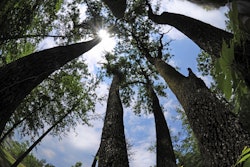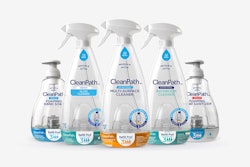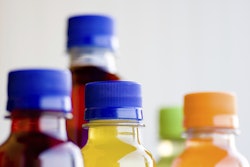Editor’s Note: Professor Flemming Besenbacher, Chairman of the Carlsberg Foundation, attracted a great deal of attention at the World Economic Forum in Davos in January when he presented a prototype of a fiber-based bottle that the group wants to launch within three years. The bottle is part of ongoing Corporate Social Responsibility (CSR) efforts within Carlsberg, and it quickly became news around the world. The technology to manufacture bottles from molded fiber in an effective and energy-efficient manner has been developed by the Danish company ecoXpac, which is now part of a development group with the DTU (Danish Technological Institute) and Carlsberg. Bo Wallteg, Editor-in-Chief of Sweden’s nord emballage, met with Carlsberg recently to learn more about the thinking behind this ambitious development. His story is reprinted here with the permission of nord emballage.
Simon Hoffmeyer Boas is Director of Corporate Communications & CSR at the Carlsberg Group, and for the past nine years he has been working to establish the concept of sustainability within the Group. For some time now, this work has mostly been focused on sustainable packaging solutions.
“There’s a good reason for this,” says Boas. “Approximately 45% of our total greenhouse gas emissions come from our packaging, so this is an area where we can make a big difference. It’s important that we take this issue seriously; we’re in a vulnerable world with limited resources, and we believe that in the future we will see a lot of new ways of working, for example by avoiding the use of fossil fuels.”
He also adds that packaging is a big part of the Carlsberg brand, and when it is improperly handled by the consumer—for example, when a glass bottle is broken and left in the countryside—this is clearly negative not only for the environment but also for the brand itself. A fiber bottle makes a statement to the consumer about sustainability, and at the same time it’s not something that’s detrimental to the countryside if it unfortunately ends up being left there.
“Obviously,” says Boas, “it’s not our intention to say to the consumer that just because it’s a fiber bottle they can throw it away anywhere. On the contrary, we want to be very clear that this type of packaging must be disposed of properly once it has been used.”
The new fiber bottle really is a unique solution. ecoXpac has been working on the development of what they call “The Green Fiber Bottle” since 2009. It can be manufactured in any size and is very strong. The walls of the bottle are thicker than plastic alternatives, but overall the bottle is lighter. It can be made in any color and can even be given relief designs. The technology makes it possible to scan any bottle and quickly produce a fiber copy. A major part of the development was finding a method for the fast and energy-efficient removal of up to 80% of the water content in the fiber after forming. This is now done using a vacuum.
Even the thread and seal on the bottle will be made of fiber in the final bottle, and this provided a big challenge. The bottle will have an internal coating, and when nord emballage visited ecoXpac last autumn the idea was to give it a plasma coating to provide a barrier that permits food contact and packaging of carbonated beverages. So far, however, this issue has not yet been decided, and the development work continues.
Last autumn ecoXpac called for a strong partner to drive development forward, and their appeal was successful.
“That the technology makes it possible to produce any shape we want and that it’s very quick to produce a new form is naturally of great interest,” says Boas. “By quick I mean just a few days. When we developed a bottle with the Carlsberg logo in relief it took only 24 hours. This opens up interesting possibilities for special editions at things like sporting events or concerts.”
More work to be done
The development has certainly come a long way, but there is still a lot of work to be done before the bottle reaches the market. Further development is expected to take another three years, and during that time a variety of studies will be carried out including studies of environmental profiles, markets, and consumers. A number of university students will be employed by the DTU to undertake the investigative work.
“It’s important that we optimise the bottle and make sure it’s in the right market with the right content and targeted at the right consumer group,” says Boas. “For this kind of work it’s an advantage to be a global consumer products company with good insights into the different markets. Each market differs widely in its requirements. In some parts of the world it’s glass, in others it has to be plastic, and here at home it’s mainly glass and metal. We will strongly emphasise the sustainability theme with this type of packaging, and I think that’s something that we can reach consumers with.”
One possible problem with a fiber bottle is that it won’t be transparent. In other words, the consumer won’t be able to see the contents. But Boas thinks this won’t be a big problem. “Obviously we have included this in our development work and realise that in some cases it may be something of a limitation, but once again, it will depend hugely on which markets and products we focus on initially. At the moment we don’t know what we will use the bottle for; we may even develop a completely new product for the bottle. But at the same time it must be borne in mind that we currently work a lot with full sleeves on glass bottles and these also prevent consumers from seeing the contents.”
Ordinary bottling line
One important aspect of the development process is to achieve a production rate that allows the fiber bottles to be manufactured at about the same rate as plastic bottles. The actual filling of the bottles should take place on the regular bottling lines with only minor adjustments.
“We will make resources available on one of our bottling lines for all test runs,” says Boas. “And since we expect the fiber bottle to be quite similar to a glass or plastic bottle, there shouldn’t be any need for major changes. However, the production rate must be increased, and therein lies one of the challenges that we will be addressing in the innovation forum that Carlsberg, ecoXpac, and the DTU have now formed. If we look back in time, we can see that the production rate of the first PET bottles was not very high.”
It would be a mistake to believe that Carlsberg’s role is merely to provide a secure financial basis for continued development. On the contrary, according to Boas, there is a great deal of scientific and technological knowledge within the group.
“In the 1800s our founder J.C. Jacobsen had a very strong belief in science and knowledge,” says Boas. “So even back then he saw Carlsberg as being built on expertise. That work led to, among other things, a method for stabilizing the yeast, a method used today by other breweries. This focus on knowledge and development means we can contribute a great deal to this project. We also have a head of innovation who is very knowledgeable within the packaging area, Håkon Langen, who will contribute significant expertise to the project.
“We are involved in the development, but our goal is not to integrate Carlsberg into a packaging company. The purely practical production issues can be solved by ecoXpac. Nor will we own this solution; it might well be available to everyone, but of course we would have a good head start given the work we’re putting in now.”
Different fibers
Wood fiber is currently the basic starting material for the new bottle, but it could also be manufactured from other fibers so long as those fibers can bind together. The type of fiber is another aspect that will also be investigated in the next few years, but as things stand today it is certified virgin wood fiber that is being used.
The new bottle will probably look very similar to bottles in use today, so it shouldn’t make any major demands on logistics, i.e. in terms of handling and distribution. It should fit well with the solutions already in use.
“We will be looking at secondary packaging as part of our work in the innovation group,” says Boas. “We hope that some of our other partners will join the group and help with this.”
The aim is for the bottle to be commercially available within three years. The innovation group is now setting up a project plan with various milestones. Carlsberg is not assuming that the new bottle will be more expensive to produce than the alternative packaging solutions. In fact it is expected that lower energy consumption will have a beneficial impact. So the consumer shouldn’t have to pay more for a product packed in this type of bottle. How quickly it will be accepted on the market and become profitable remains to be seen. As with all new ideas this will probably take some time. A great deal rests on the important work of finding the right market, product, and demographic.
“We are announcing this now as a way of giving consumers time to get used to the idea that something new is going to appear,” says Boas. “We will most probably release the bottle onto a pilot market first. That is how we usually work.”
CCC
CCC stands for the Carlsberg Circular Community, which is inspired by “cradle-to-cradle” thinking. Until recently, there were seven partners in this “circle,” whose goal is to reduce environmental impact. Now there is an eighth in the form of ecoXpac. The circle includes manufacturers of glass, plastic, metal, and paper packaging. One might imagine that there is a risk of them feeling threatened by the newcomer, especially given that there have been rumours that Carlsberg’s ambition is for all of their products to be packaged in fiber bottles in the future. However, this is firmly denied by Boas.
“There are no such plans for the foreseeable future,” he says, adding that the new bottle has received positive responses from the other companies within the circle. “We will not be discriminating against any types of packaging, but we do believe that all packaging can be optimised. Our goal with the circle is that everyone has a place as long as they have the ambition to optimise their solutions. I think that this will push them to further action. The fiber bottle gives us another option in our packaging portfolio, and that’s positive.”
Social media discussion
There was a record level of interest when Flemming Besenbacher announced the new bottle in Davos, so much so that even Carlsberg was a little surprised.
“We were pleasantly surprised,” says Boas. “We hadn’t expected this much interest. From some quarters, for example in Canada, there has been enormous interest and on social media it has spread rapidly. There have been discussions there about the challenges we will face, and I hope and believe that this is part of a growing global understanding of the concept of sustainability; if so we have already succeeded.”
The bottle Boas showed off during the interview was a test bottle from ecoXpac and not Carlsberg’s own finished solution. Because of this he preferred us not to photograph the whole bottle, but we are able to present the three-dimensional logo. As things stand now, it’s a good bet we’ll be seeing more of them in the future.
Watch a video that details the Green Fiber Bottle technology at pwgo.to/1516



























